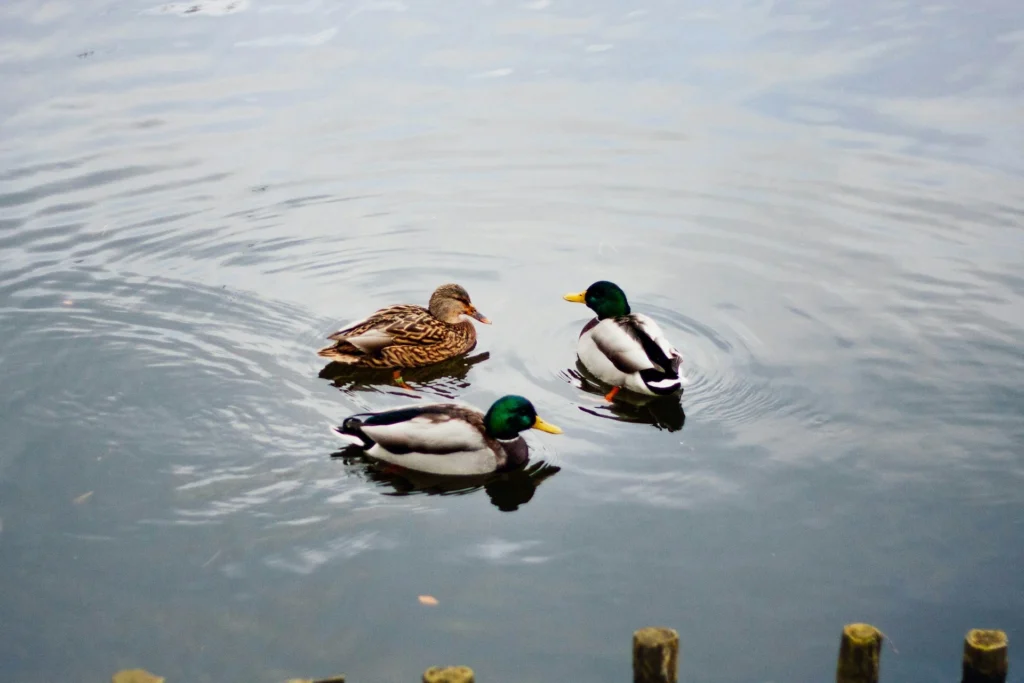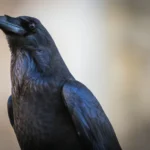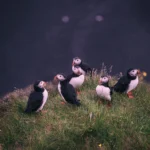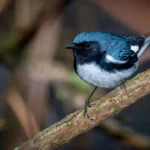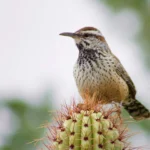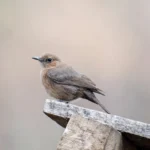Texas is a haven for duck lovers. With its vast wetlands, coastal bays, and inland lakes, the Lone Star State hosts one of the most diverse waterfowl populations in the United States. Whether you’re exploring marshes along the Gulf Coast or scanning prairie ponds in the Panhandle, you’re bound to spot a colourful variety of ducks year-round.
Ducks in Texas come in all shapes and sizes—from the elegant Northern Pintail to the vibrantly plumaged Wood Duck. Some species breed here during spring and summer, while others make Texas a temporary stopover during their winter migration. And it’s not just ducks you’ll find. Several other waterbirds, like coots and grebes, share similar features and habitats, often confusing even seasoned birders.
This guide explores the most common types of ducks in Texas as well as a few duck-like species that are often found in the same wetlands. Each bird is described with helpful ID tips, range insights, feeding habits, and more—perfect for birdwatchers, photographers, and nature lovers alike.
So grab your binoculars, and let’s dive into the fascinating world of Texas ducks and their look-alike cousins!
Table of Contents
True species of Ducks in Texas
1. Mallard (Anas platyrhynchos)
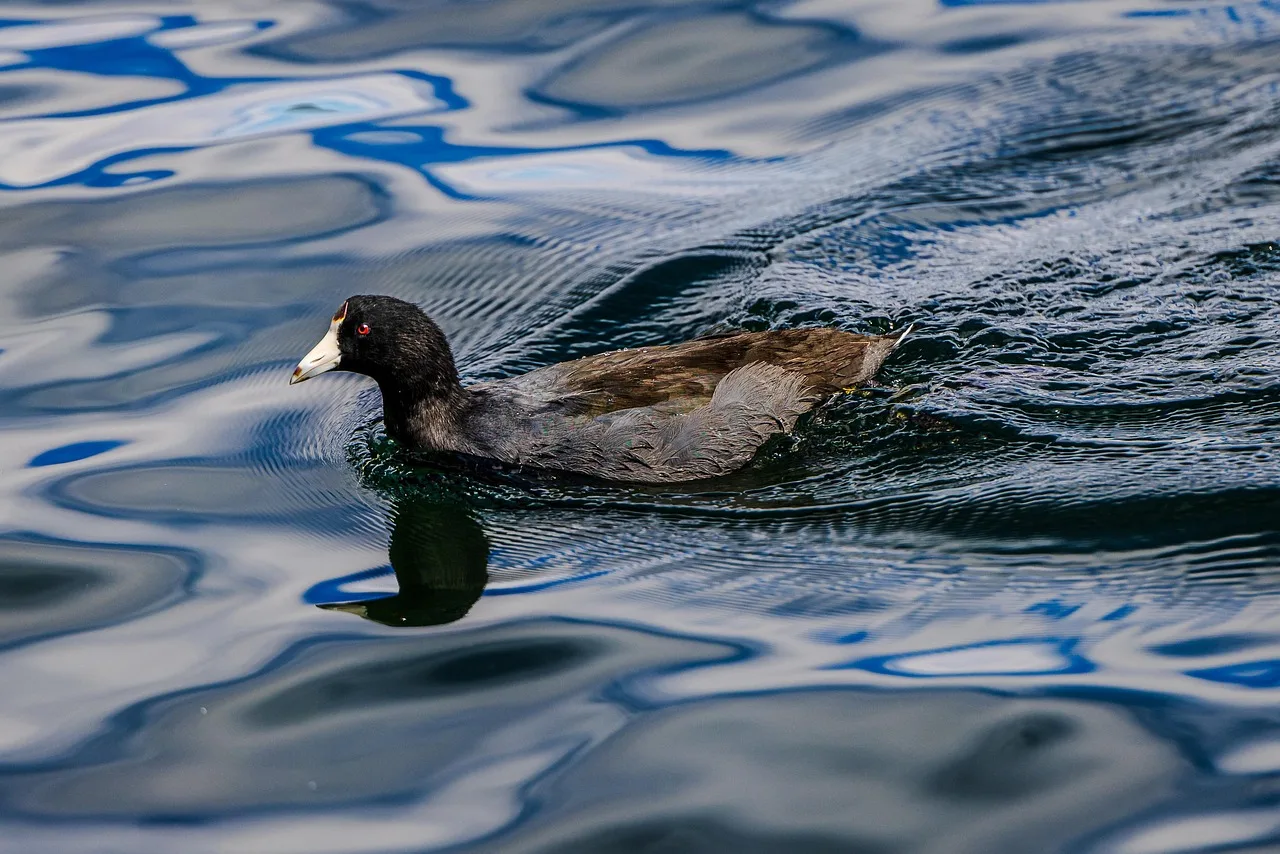
Appearance
The Mallard is one of the most easily recognized ducks in North America. Males have a glossy green head, bright yellow bill, white neck ring, and grayish body with a black tail. Females are mottled brown with orange bills marked by black blotches. Both sexes have a vibrant blue wing patch (speculum) bordered with white, visible in flight.
Habitat and Range in Texas
Mallards are found year-round throughout Texas. They thrive in city parks, ponds, lakes, rivers, and wetlands—anywhere there’s water. They’re especially common in East and Central Texas but can be seen statewide.
Diet
Mallards are dabbling ducks, meaning they feed at or just below the surface without diving. Their omnivorous diet includes:
- Aquatic plants and algae
- Seeds and grains
- Insects and crustaceans
- Occasionally small fish
In urban areas, they may also forage on bread or grains left by humans, though this isn’t recommended for their health.
Also read: TYPES OF Black Birds in South Carolina
Behavior
Mallards are social, often seen in mixed flocks during migration. They’re excellent flyers and are usually the first ducks to return to breeding areas in early spring. Males give a soft “rhaeb” while females make the classic “quack.”
Breeding
In Texas, Mallards nest in spring and early summer. The female chooses a spot on the ground near water and builds a nest lined with her own down feathers. She lays 8–13 eggs and cares for the ducklings alone after they hatch.
Fun Fact
Mallards are the ancestor of nearly all domestic duck breeds. Their adaptability to both wild and urban settings makes them one of the most successful waterfowl species on Earth.
2. Blue-winged Teal (Spatula discors)
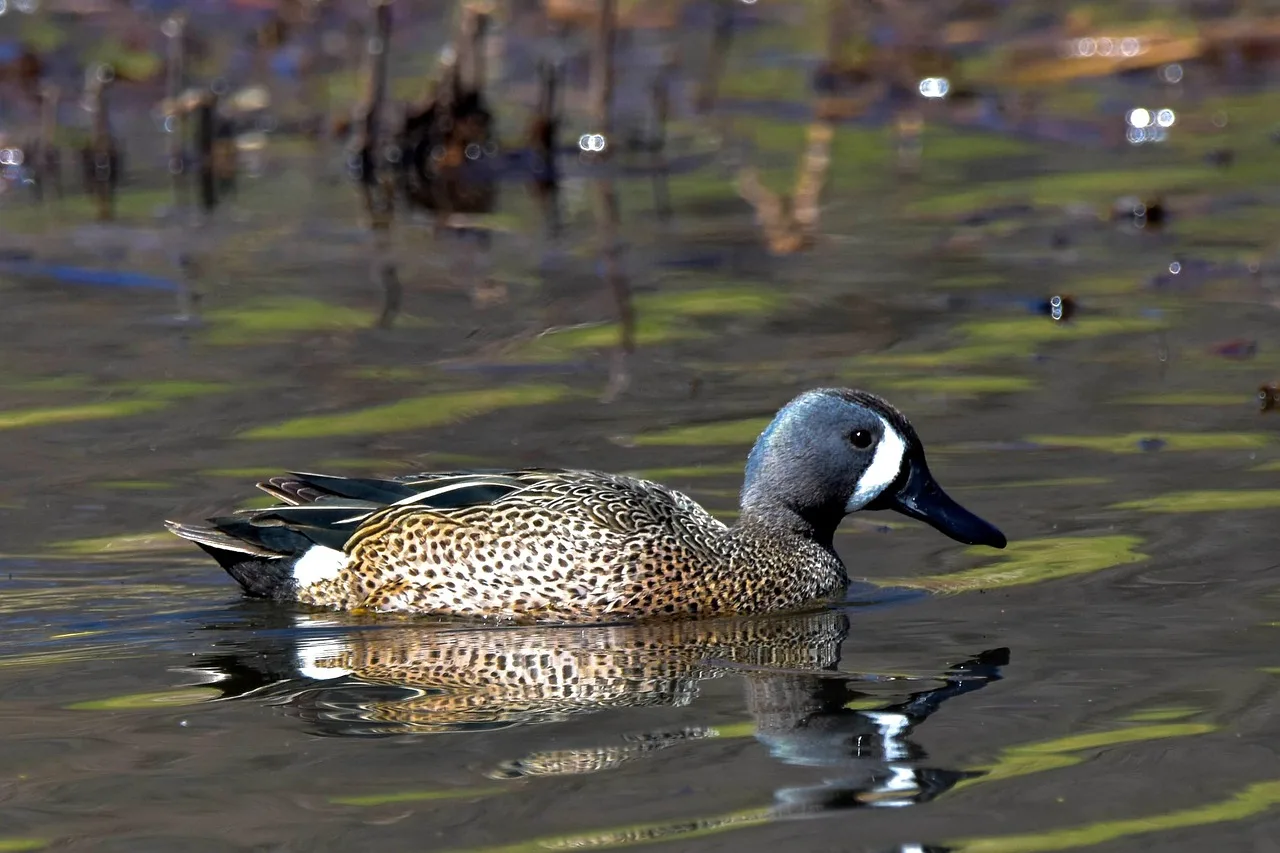
Appearance
The Blue-winged Teal is a small and slender dabbling duck with distinctive features. Males sport a bold white crescent in front of the eye, a spotted brown body, and powder-blue wing patches visible in flight. Females are mottled brown and more subdued, but also show blue upper wings when flying.
Habitat and Range in Texas
Blue-winged Teals are common in Texas during migration and breed in the northern and central parts of the state. You’ll often spot them in shallow ponds, marshes, flooded fields, and seasonal wetlands—especially from March to May and again in September to November.
Diet
These agile dabblers feed in shallow waters and muddy edges. Their diet includes:
- Aquatic insects
- Seeds and grasses
- Algae and duckweed
- Small crustaceans
They often feed by skimming the surface or tipping forward in water rather than diving.
Behavior
Blue-winged Teals are among the first ducks to migrate south in fall and among the last to return in spring. They’re fast flyers and usually travel in tight, zig-zagging flocks. Their flight is quick, erratic, and low over water—making them a favourite among birders and hunters.
Breeding
Females build nests in dense grasses, often far from water. The nests are shallow scrapes lined with grasses and down. Blue-winged Teals are secretive during breeding, and their nests are well hidden. Clutches usually contain 9–12 eggs.
Fun Fact
Despite their small size, Blue-winged Teals are long-distance migrants. Some individuals travel all the way to South America for the winter, passing right through Texas wetlands en route.
Also read: Birds That Look Like Ostriches
3. Gadwall (Mareca strepera)
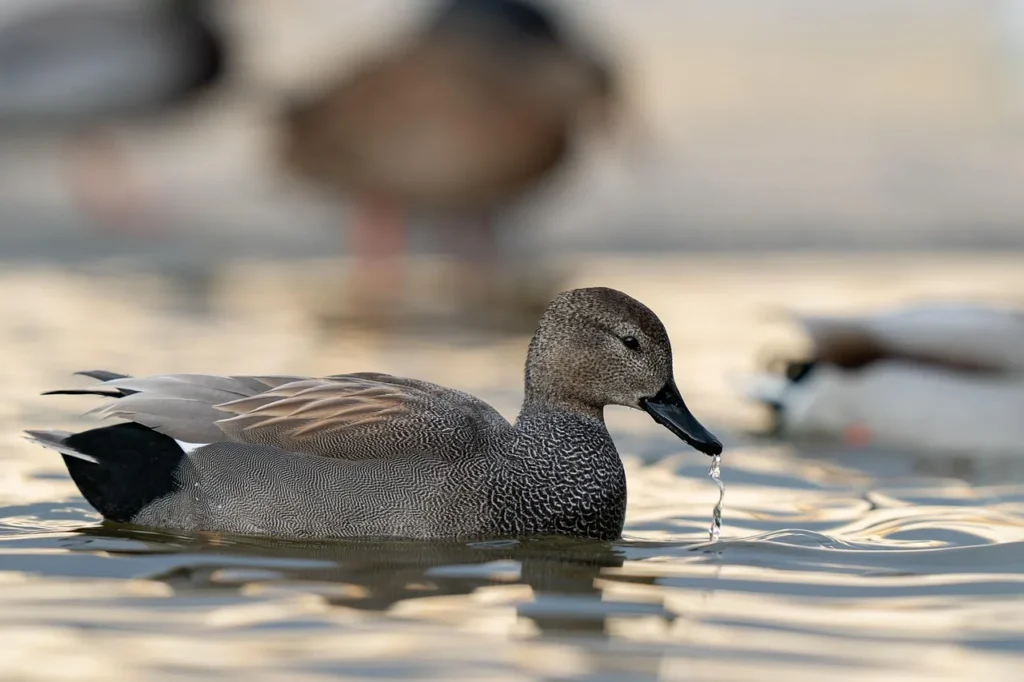
Appearance
The Gadwall may not be as flashy as other ducks, but its subtle elegance makes it a favourite among birders. Males are mostly gray-brown with a black rump and white wing patch that’s only visible in flight. Females resemble female Mallards with mottled brown plumage but lack the orange bill and blue speculum.
Habitat and Range in Texas
Gadwalls are common winter visitors and local breeders in Texas. They’re typically found in:
- Shallow freshwater ponds and marshes
- Slow-moving rivers
- Wetlands with plenty of submerged vegetation
They’re particularly abundant in the eastern half of the state during the cooler months.
Diet
Gadwalls are primarily herbivorous. They forage by dabbling or grazing and feed on:
- Pondweed
- Wigeon grass
- Algae
- Seeds of aquatic plants
Occasionally, they’ll supplement their diet with insects or small crustaceans.
Behavior
Gadwalls are often seen in mixed flocks with other ducks, especially American Wigeons and Northern Shovelers. They are quieter than most dabblers but may produce soft, raspy quacks or whistles. Males often steal food from diving ducks, a behaviour called “kleptoparasitism.”
Breeding
Some Gadwalls breed in the Texas Panhandle and High Plains. The female nests on the ground in dense vegetation, often close to water. She lays 7–12 eggs, and the young can feed themselves within a day of hatching.
Fun Fact
Unlike many other ducks, Gadwalls have a distinctive white wing patch instead of colourful blues or greens—making them easier to ID in flight once you know what to look for.
4. Bufflehead (Bucephala albeola)

Appearance
Buffleheads are among the smallest diving ducks in North America—but they pack a lot of character. Males are striking: glossy black-and-white with a large, iridescent head marked by a bold white patch behind the eye. Females and immatures are more subtle, with gray-brown plumage and a smaller white cheek patch.
Habitat and Range in Texas
Buffleheads are migratory winter visitors to Texas, most common from late fall through early spring. You’ll often find them in:
- Sheltered coastal bays
- Lakes and reservoirs
- Slow-moving rivers and ponds with plenty of space to dive
They prefer open water but can also be spotted near wooded shorelines.
Diet
Buffleheads are agile divers, feeding mainly underwater. Their diet includes:
- Aquatic insects and larvae
- Crustaceans (like small shrimp and amphipods)
- Mollusks
- Some aquatic plants and seeds
They dive frequently, often staying submerged for 10–25 seconds.
Behavior
Buffleheads are quick, buoyant swimmers and strong fliers. While quiet for most of the year, males give a high-pitched squeak during courtship. They’re often seen in small groups or pairs, rarely in large flocks.
Breeding (Outside Texas)
Though they don’t breed in Texas, Buffleheads nest in tree cavities, especially abandoned Northern Flicker holes, in Canada and the northern U.S. The female lays 6–11 eggs and tends the nest high above the ground.
Fun Fact
Buffleheads are one of the few duck species that can fly directly from the water into a tree cavity—thanks to their compact size and powerful wings.
5. Cinnamon Teal (Spatula cyanoptera)
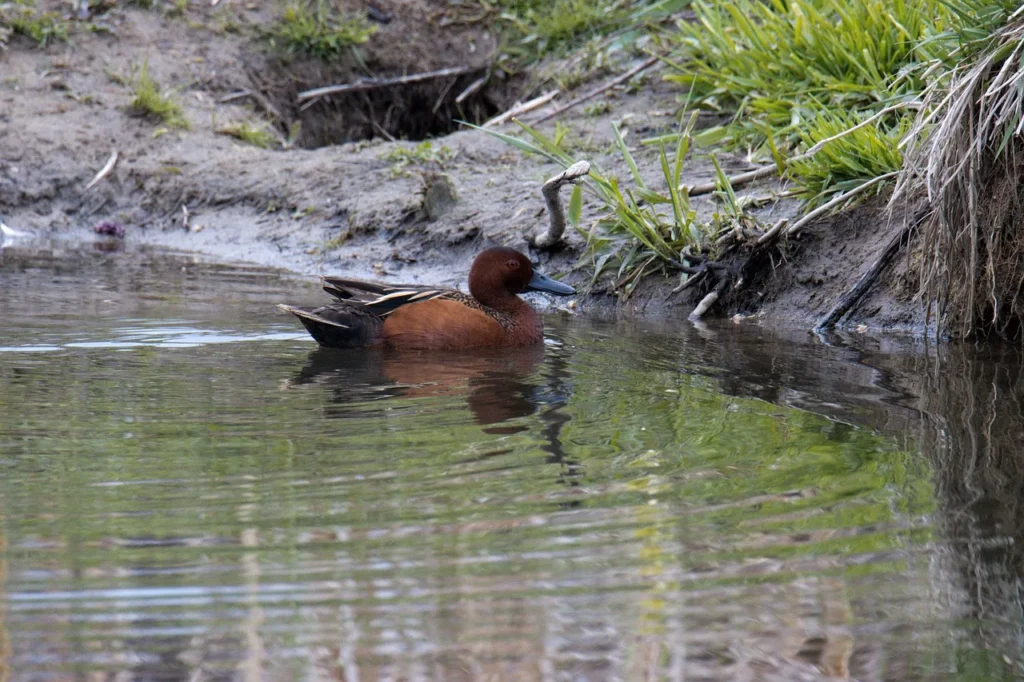
Appearance
The Cinnamon Teal is a standout among Texas ducks. Males in breeding plumage are unmistakable, with rich reddish-cinnamon bodies, bright red eyes, and dark bills. Females are mottled brown, resembling Blue-winged Teals but with a slightly larger size and duller coloration. Both sexes have blue shoulder patches visible in flight.
Habitat and Range in Texas
Cinnamon Teals are considered rare breeders and seasonal migrants in Texas. They’re more frequently seen during spring and fall migration, primarily in:
- Shallow freshwater marshes
- Irrigated fields and flooded meadows
- Prairie potholes and seasonal wetlands in western Texas
They prefer calm, vegetated waters with plenty of shoreline cover.
Diet
Cinnamon Teals forage by dabbling and filtering through mud. Their varied diet includes:
- Seeds from aquatic grasses
- Aquatic insects and larvae
- Crustaceans
- Algae and pondweed
They primarily feed during early morning and late afternoon.
Behavior
Generally quiet and shy, Cinnamon Teals are not as gregarious as other dabbling ducks. Males may perform head-bobbing displays during courtship. Their swift, direct flight and low profile on water make them harder to spot in dense vegetation.
Breeding
While breeding in Texas is rare, when it does occur, females build nests in grassy areas close to water. They lay 8–10 eggs in shallow depressions, well concealed by plant cover. Ducklings are precocial and leave the nest within a day of hatching.
Fun Fact
The Cinnamon Teal is mostly a western species and is one of the few North American ducks found as far south as Chile and Argentina during winter migration.
6. American Wigeon (Mareca americana)
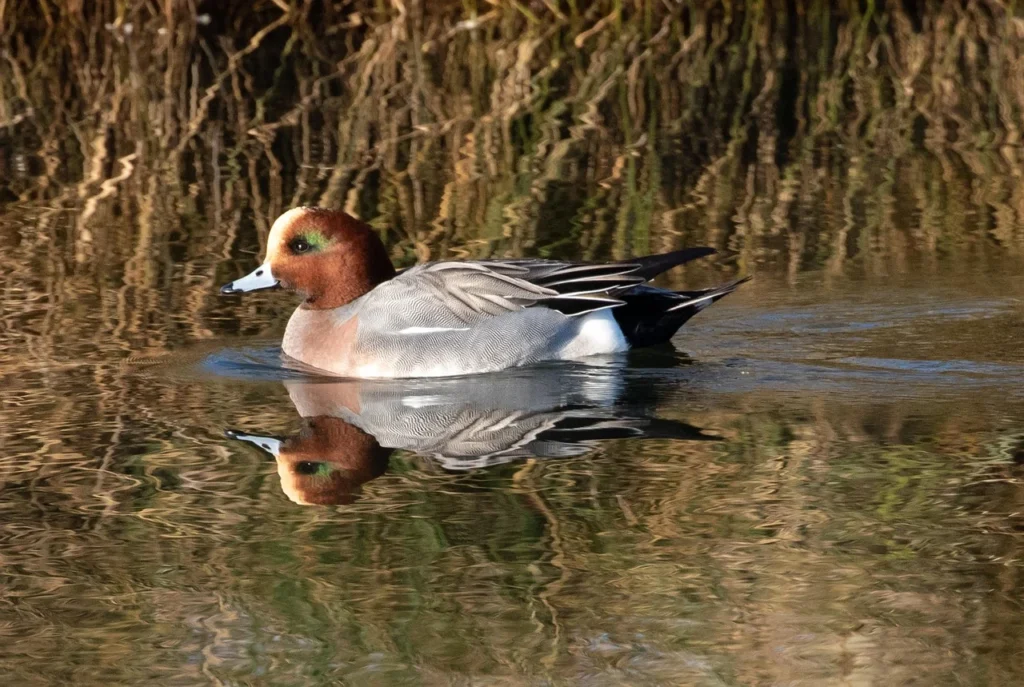
Appearance
The American Wigeon, sometimes nicknamed “baldpate,” is a medium-sized duck known for its elegant colouring. Males feature a distinctive white forehead, green band behind the eye, and pinkish-brown body. Females are mostly gray-brown with a pale head and subtle markings. Both sexes show a white belly and striking white wing patches in flight.
Habitat and Range in Texas
American Wigeons are migratory and common throughout Texas, especially from late fall to early spring. They are found in:
- Freshwater marshes
- Stock ponds and reservoirs
- Coastal wetlands and estuaries
- Urban retention ponds and golf courses
They often gather in large flocks during winter.
Diet
Wigeons are often called “grazing ducks” for their preference for land-based plants. Their diet includes:
- Grasses and sedges
- Aquatic plants like duckweed
- Crop grains (rice, wheat, barley)
- Occasional aquatic invertebrates
They also steal food from diving ducks like coots, earning them a reputation as clever opportunists.
Behavior
American Wigeons are vocal ducks. Males emit a soft, three-note whistle that sounds like “whew-whew-whew,” while females produce low grunts. They’re often seen resting on open water or grazing in nearby fields.
Breeding (Outside Texas)
Breeding takes place further north in the U.S. and Canada. Females build concealed ground nests in tall grass or shrubs near water, laying 8–10 eggs. Chicks are active shortly after hatching and follow the mother to water.
Fun Fact
Despite being dabblers, American Wigeons often spend more time foraging on land than in water, unlike most other ducks in Texas.
7. Green-winged Teal (Anas crecca)
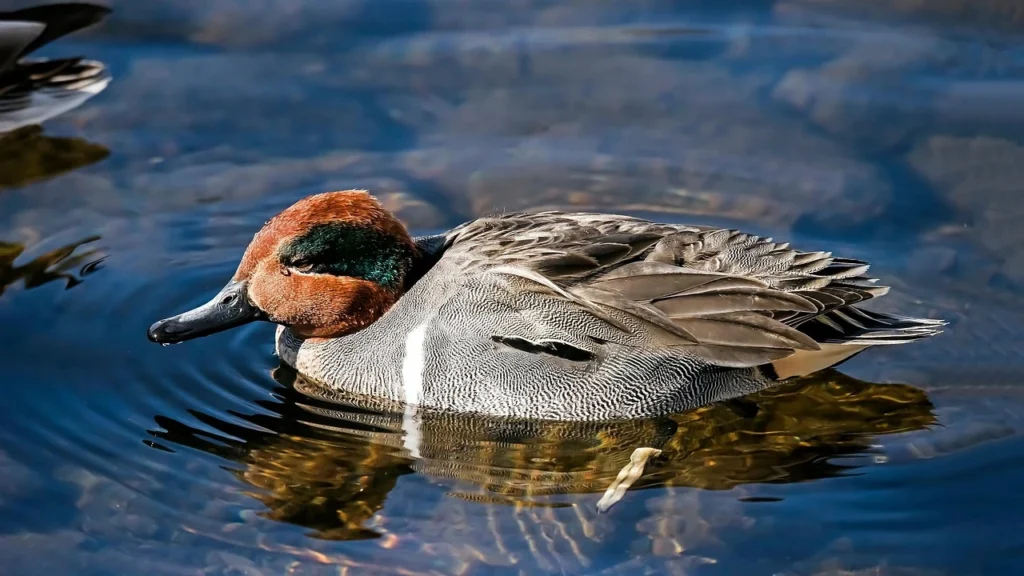
Appearance
The Green-winged Teal is the smallest dabbling duck in North America, but it’s big on beauty. Males sport a chestnut head with a vivid green eye patch, a greyish body, and a vertical white bar on the side. Females are mottled brown with a compact body and subtle markings, but both sexes display a brilliant green wing patch in flight.
Habitat and Range in Texas
This teal is a common winter visitor throughout Texas. You’ll spot them from late fall through early spring in:
- Shallow freshwater ponds
- Coastal marshes
- Rice fields and flooded lowlands
- Edges of lakes and reservoirs
They often form dense flocks and are easily spooked into swift flight.
Diet
Green-winged Teals are dabblers, feeding mostly in shallow waters. Their diet includes:
- Seeds from grasses and aquatic vegetation
- Aquatic insects and crustaceans
- Small snails and zooplankton
They prefer feeding near the surface and along muddy shores.
Behavior
These energetic little ducks are fast flyers and often the first to take off when disturbed. Males give high-pitched whistles, while females make soft quacking sounds. They’re social and often mix with other teal species during migration.
Breeding (Outside Texas)
Breeding occurs in northern regions of North America. Females choose ground nests concealed in dense grasses near water. Clutches usually contain 6–10 eggs, and ducklings leave the nest soon after hatching.
Fun Fact
Green-winged Teals are among the earliest migrants, sometimes arriving in Texas as early as late August—a welcome sight to birders and waterfowl hunters alike.
8. Harlequin Duck (Histrionicus histrionicus)
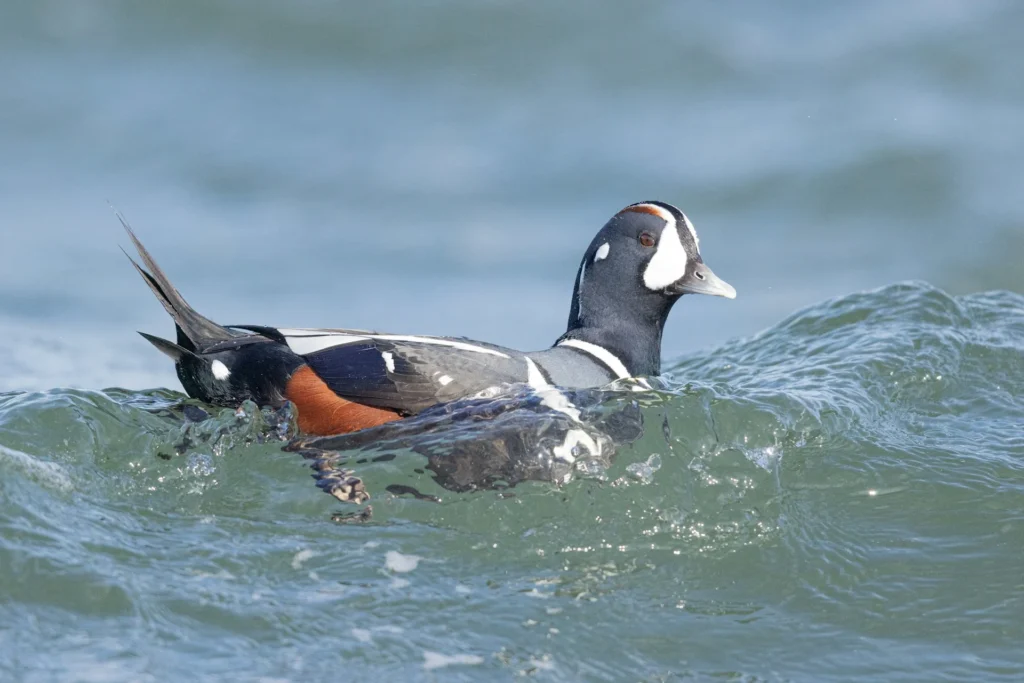
Appearance
The Harlequin Duck is one of the most visually striking ducks in North America. Males have a dramatic plumage with slate-blue, chestnut, and white markings, including bold white spots on the head and neck. Females are more understated, with brown-gray bodies and a small round white patch near the eyes.
Habitat and Range in Texas
This species is extremely rare in Texas, but occasional sightings occur along rocky Gulf Coast shores during winter migration. It’s more commonly found in fast-flowing streams in the Pacific Northwest and along coastal waters in the northeast.
In Texas, any Harlequin Duck encounter is considered special and often draws birdwatchers hoping to spot a rare migrant.
Diet
Harlequin Ducks are adept divers, feeding mostly on:
- Aquatic insects
- Crustaceans (especially crabs and shrimp)
- Small mollusks
- Fish eggs and larvae
They use their compact bodies and strong legs to navigate turbulent waters with remarkable agility.
Behavior
They’re highly adapted to rugged environments. Unlike other ducks, Harlequins are rarely seen loafing in calm waters—they prefer the thrill of swift rivers or crashing surf. Their call is a soft squeaky whistle, earning them the nickname “sea mice.”
Breeding (Outside Texas)
They breed along mountain streams in places like Montana, Wyoming, and Alaska. Nesting typically occurs in rocky crevices or tree roots along riverbanks. Chicks are led to turbulent waters almost immediately after hatching.
Fun Fact
Harlequin Ducks are named after colourful stage clowns of Renaissance Italy, thanks to their playful and vividly patterned appearance.
9. Northern Shoveler (Spatula clypeata)
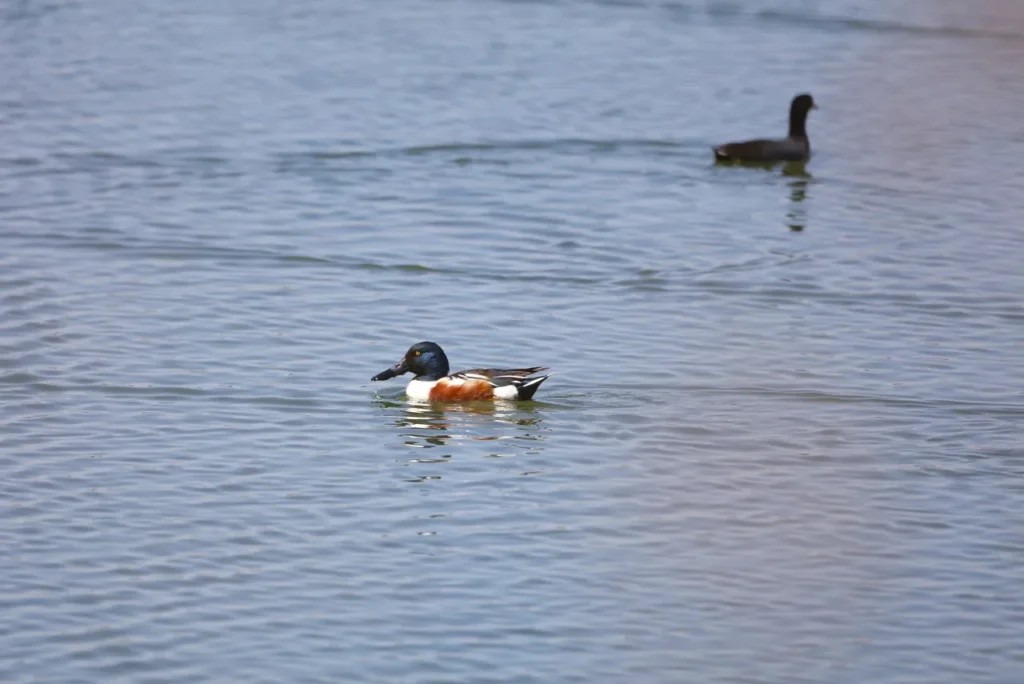
Appearance
The Northern Shoveler is instantly recognizable thanks to its oversized, spoon-shaped bill. Males are striking in breeding plumage: iridescent green heads, white chests, and chestnut flanks. Females are more camouflaged in mottled brown but share the same broad, flat bill that gives this duck its name.
Habitat and Range in Texas
Common across marshes, wetlands, and shallow lakes throughout Texas, especially during the cooler months. They are:
- Migratory and arrive in large numbers in fall and winter
- Seen in coastal prairies, playa lakes, and flooded rice fields
They tend to prefer shallow waters with abundant floating vegetation.
Diet
Northern Shovelers feed primarily by skimming the water’s surface, filtering tiny organisms with their wide bills. Their diet includes:
- Zooplankton and aquatic insects
- Algae and aquatic plants
- Seeds and crustaceans
This unique feeding style sets them apart from most dabbling ducks.
Behavior
Shovelers often swim in tight circles, stirring up food from the bottom to the surface. They’re social birds and can be seen in dense feeding flocks. Males give a low, nasal “took-took,” while females quack more softly than Mallards.
Breeding (Outside Texas)
They typically breed in prairie potholes and wetlands of the Northern U.S. and Canada. Females build ground nests concealed in grass, laying around 8–12 eggs.
Fun Fact
Despite their large bills, Northern Shovelers are among the least aggressive dabblers, often avoiding conflict and feeding peacefully in groups.
10. Wood Duck (Aix sponsa)
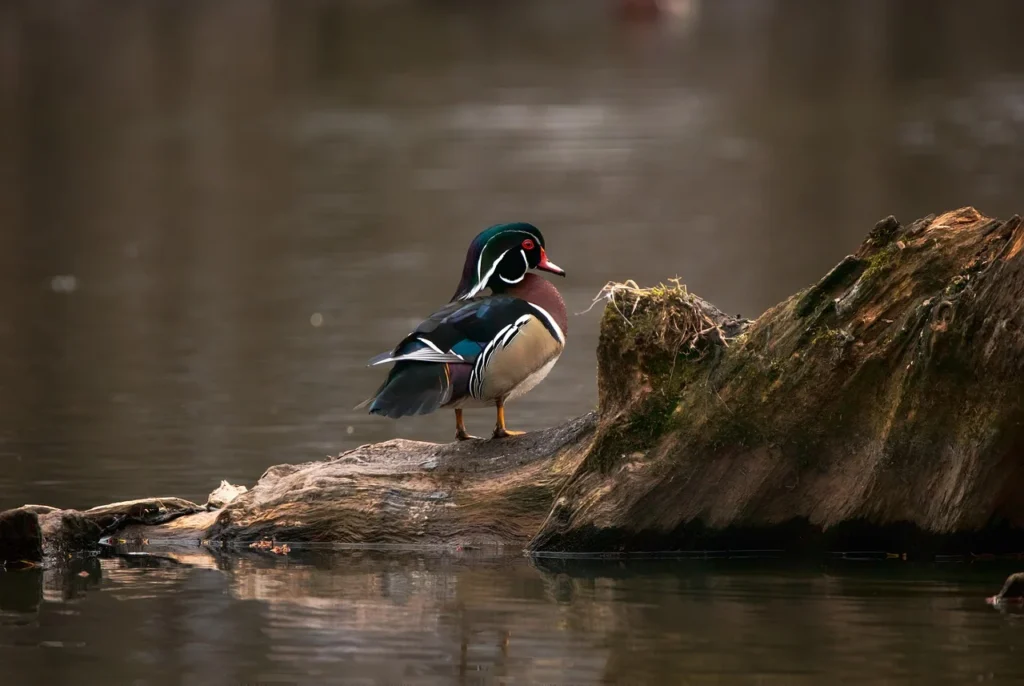
Appearance
The male Wood Duck is among the most vividly colored ducks in North America, with an iridescent green and purple head, red eyes, a white throat stripe, and chestnut chest. Females are more muted but elegant, featuring a teardrop-shaped white eye ring and soft gray-brown plumage.
Habitat and Range in Texas
Wood Ducks are commonly found in forested wetlands, cypress swamps, and slow-moving rivers and streams across East and Central Texas. They are:
- Year-round residents in many parts of the state
- Breeding in wooded areas with water access
They readily use nest boxes in conservation areas and backyards near water.
Diet
These ducks are highly omnivorous and versatile in their feeding:
- Seeds, acorns, and berries
- Aquatic insects, snails, and crustaceans
- Occasionally small fish and amphibians
They forage in both trees and water, making them more flexible than most ducks.
Behavior
Wood Ducks are agile flyers and strong swimmers. Unlike many duck species, they perch in trees and often nest in tree cavities, sometimes 20–30 feet off the ground. Ducklings famously leap from the nest a day after hatching to follow their mother to water.
Their vocalizations are distinct:
- Males give a high-pitched whistle
- Females emit a sharp “oo-eek” sound
Breeding
In Texas, Wood Ducks nest from late winter through early summer, laying 7–15 eggs per clutch. Thanks to nest box programs and wetland preservation, their populations have rebounded significantly.
Fun Fact
Wood Ducks were once nearing extinction due to overhunting and habitat loss, but they are now a major conservation success story, thanks to human intervention.
11. Northern Pintail (Anas acuta)
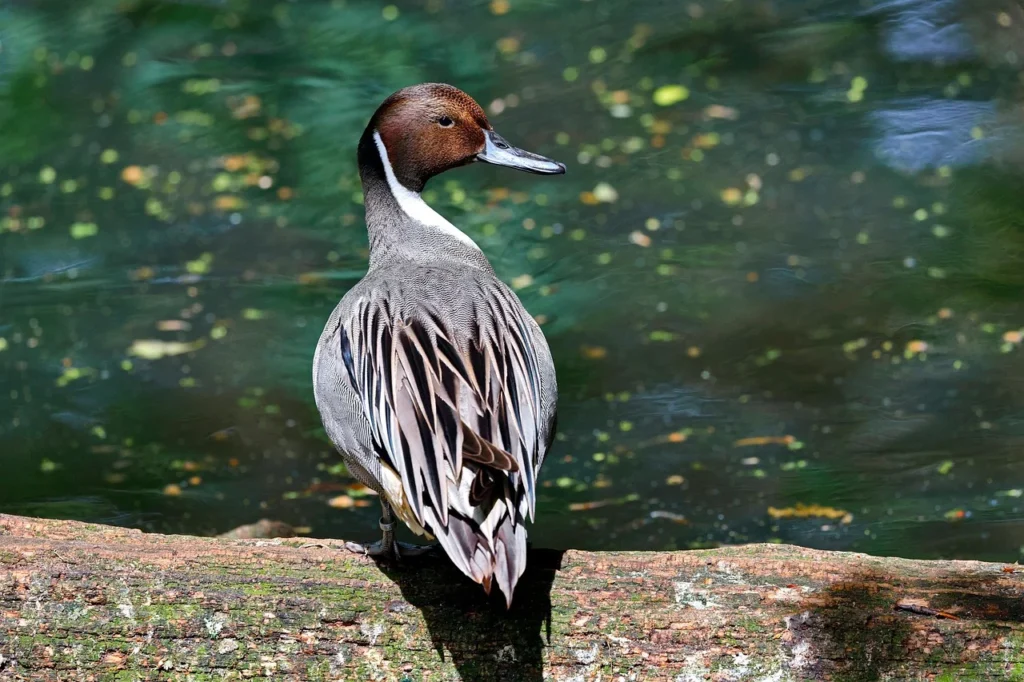
Appearance
Northern Pintails are slender, long-necked ducks with a distinctive silhouette. Males feature:
- Chocolate-brown heads
- White necks and underparts with a thin white stripe running up the side of the neck
- Grayish flanks and long, black central tail feathers
Females are more muted, sporting mottled brown plumage and a more subtle version of the male’s graceful shape.
Habitat and Range in Texas
In Texas, Northern Pintails are winter migrants, commonly seen in:
- Coastal wetlands
- Flooded rice fields and freshwater marshes
- Panhandle playas and prairie ponds
Their presence is strongest in fall through early spring, often in large mixed flocks with other dabbling ducks.
Diet
Pintails are dabblers and prefer shallow waters. Their diet includes:
- Seeds and grains (especially rice and smartweed)
- Aquatic plants and pondweeds
- Insects and small aquatic invertebrates
They often forage in agricultural fields and are drawn to recently flooded areas.
Behavior
Northern Pintails are known for their graceful flight and sleek appearance. They migrate in impressive flocks, often covering thousands of miles between breeding and wintering grounds. They’re also quieter than many ducks, with males emitting a soft whistle and females producing a hoarse quack.
Breeding (Outside Texas)
They breed in the northern prairies of the U.S. and Canada, choosing open fields and grasslands near water. Females lay around 6–12 eggs and incubate them for about three weeks.
Fun Fact
Because of their elegant shape and swift flight, the Northern Pintail is sometimes called the “greyhound of the skies.” They are one of the earliest migratory ducks to arrive in Texas each fall.
12. Canvasback (Aythya valisineria)
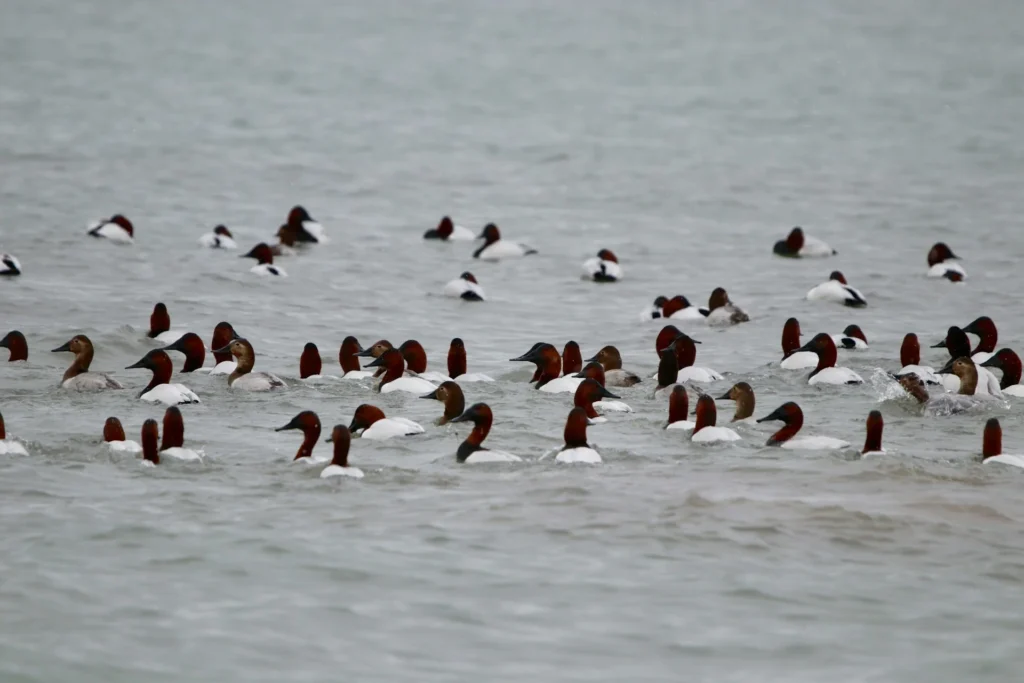
Appearance
The Canvasback is instantly recognizable for its:
- Sloping red head and long black bill
- Pale grayish-white body that resembles canvas (hence the name)
- Black chest and tail feathers
Females are subtler in appearance, with a brownish head and tan body, yet they share the same sleek, wedge-shaped profile.
Habitat and Range in Texas
Canvasbacks are migratory visitors to Texas and are most commonly spotted during fall and winter. Key areas include:
- Coastal bays and estuaries
- Inland reservoirs and deep lakes
- Open wetlands and flooded grain fields
They prefer deeper water bodies compared to dabbling ducks.
Diet
Canvasbacks are specialist divers that forage underwater, primarily feeding on:
- Aquatic tubers, especially wild celery (Vallisneria)
- Other submerged plants
- Occasionally insects, snails, and small fish
Their long, narrow bill is perfectly suited for grasping underwater vegetation.
Behavior
These ducks are strong, fast flyers, known for their powerful, direct wingbeats. Unlike dabblers, Canvasbacks dive completely underwater to feed and often stay submerged for 10–20 seconds at a time.
They are quieter than most ducks, but males sometimes give a low “whoop” sound during courtship.
Breeding (Outside Texas)
Canvasbacks breed in the prairie pothole region of the U.S. and Canada, choosing deep-water wetlands with ample vegetation for nesting. Their nests are often floating platforms anchored to reeds or bulrushes.Conservation Status
Currently listed as Vulnerable, Canvasbacks face threats from:
- Wetland loss and pollution
- Degradation of food sources like wild celery
Conservation programs focus on protecting stopover wetlands and breeding habitats along migration corridors.
14. Redhead (Aythya americana)
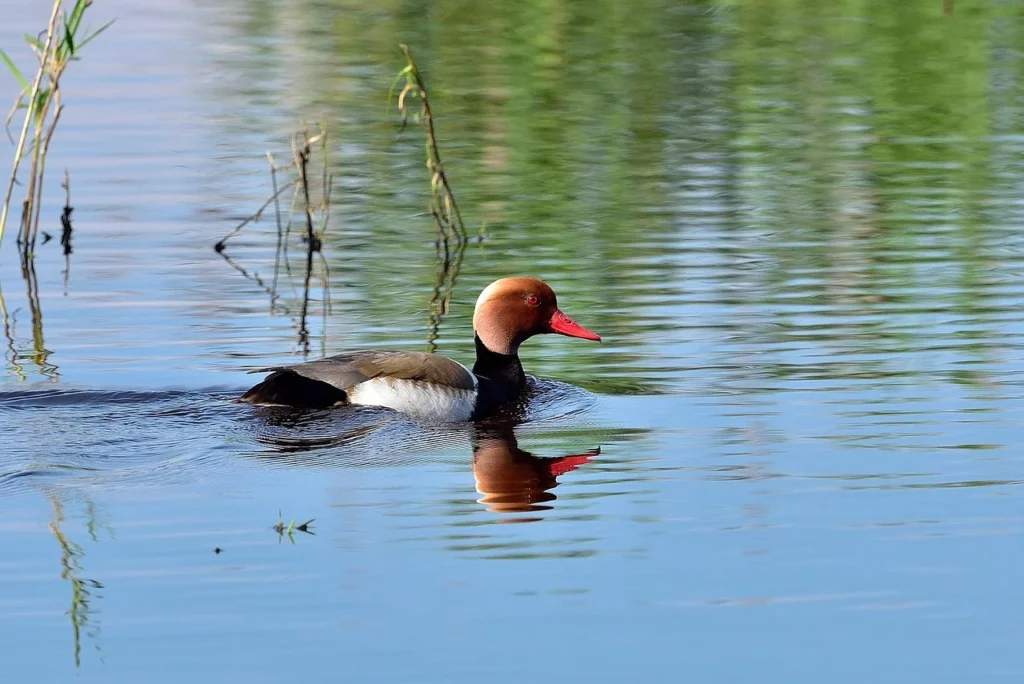
Appearance
The Redhead is a medium-sized diving duck known for its striking red head and neck, black breast, and light grey body. Males are unmistakable with their bold coloration, while females are uniformly brown with a paler face and a bluish-gray bill. Their rounded head and sloping forehead help distinguish them from similar diving ducks like Canvasbacks.
Habitat and Range in Texas
Redheads are migratory and commonly winter in Texas, especially along the Gulf Coast. Key habitats include:
- Coastal bays and estuaries
- Large inland lakes and reservoirs
- Shallow freshwater marshes
- Protected brackish wetlands and lagoons
Texas’s Laguna Madre is a globally important wintering site, often hosting tens of thousands of Redheads at once.
Diet
Redheads dive for food in both fresh and saltwater. Their primary diet includes:
- Aquatic plants like pondweeds and wild celery
- Seeds and tubers from submerged vegetation
- Occasional insects, mollusks, and small crustaceans
They forage by diving or tipping underwater, especially in groups.
Behavior
Redheads are gregarious and social, often forming large flocks outside of the breeding season. They may associate with other diving ducks but generally stick together. Males give a soft “whee-o” whistle, while females produce a series of low quacks.
Breeding (Outside Texas)
They typically breed in the northern Great Plains and Canadian prairies. Nests are built over water among thick emergent vegetation. Females lay 7–10 eggs, and interestingly, Redheads are known for parasitizing the nests of other duck species like Canvasbacks by laying eggs in them.
Fun Fact
Over 80% of the continental Redhead population winters along the Texas Gulf Coast—making the Lone Star State vital for their survival!
13. Ring-necked Duck (Aythya collaris)
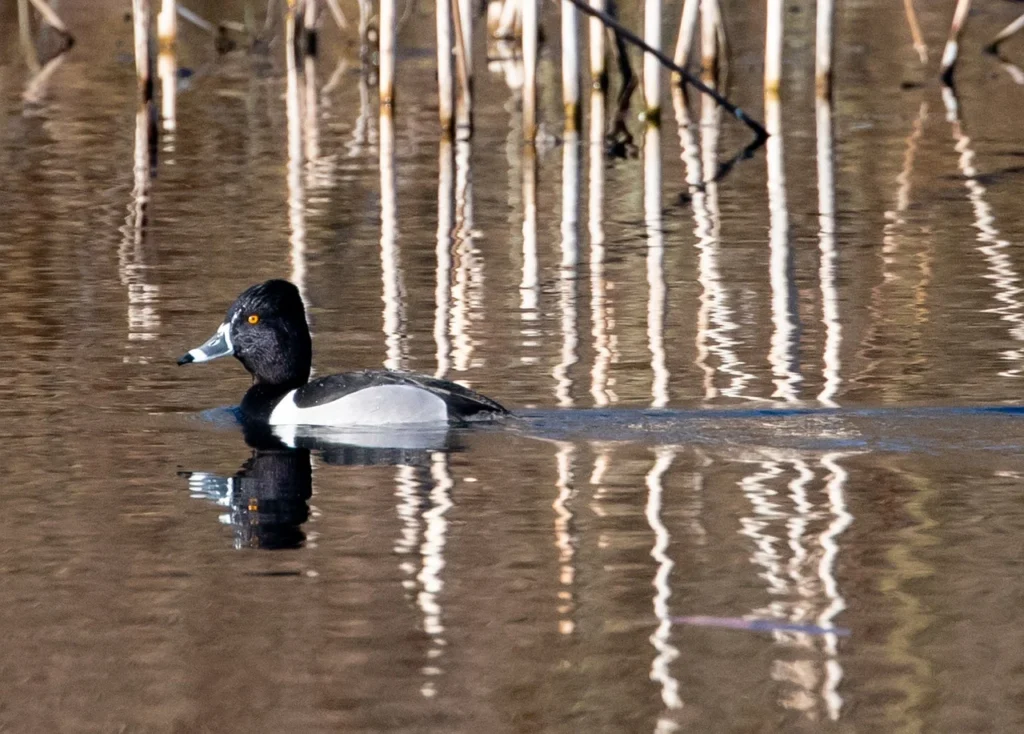
Appearance
Despite its name, the Ring-necked Duck is more easily identified by its ringed bill than the faint chestnut ring around the neck. Males feature a striking black head, chest, and back, with grey sides and a white ring near the tip of the bill. Females are brown with a pale face and white eye ring, offering excellent camouflage in wetland vegetation.
Habitat and Range in Texas
Ring-necked Ducks are migratory visitors throughout Texas during the fall and winter months. Preferred habitats include:
- Freshwater lakes and reservoirs
- Marshes and wooded ponds
- River oxbows and floodplain wetlands
They are more commonly found in inland wetlands than coastal areas and often in flocks mixed with other diving ducks.
Diet
As a diving duck, the Ring-necked Duck forages underwater for:
- Submerged aquatic plants like pondweed and wild celery
- Seeds and tubers from wetland vegetation
- Aquatic insects, snails, and crustaceans
Their feeding technique includes short, agile dives and upending near aquatic vegetation.
Behavior
These ducks are generally quiet but can become vocal during courtship. Males may give a whining, nasal call, while females produce a harsh grating noise. They are strong fliers, often taking off almost vertically from the water—a distinctive trait among divers.
Breeding (Outside Texas)
They breed mainly in the northern U.S. and southern Canada, favoring forested wetlands. Females nest near water, typically among dense vegetation. Clutches usually consist of 8–10 eggs, and ducklings are highly mobile soon after hatching.
Fun Fact
Despite being named for a neck ring, most birdwatchers identify this species by its bill markings, making it one of the more “misnamed” ducks in North America.
14. Ruddy Duck (Oxyura jamaicensis)
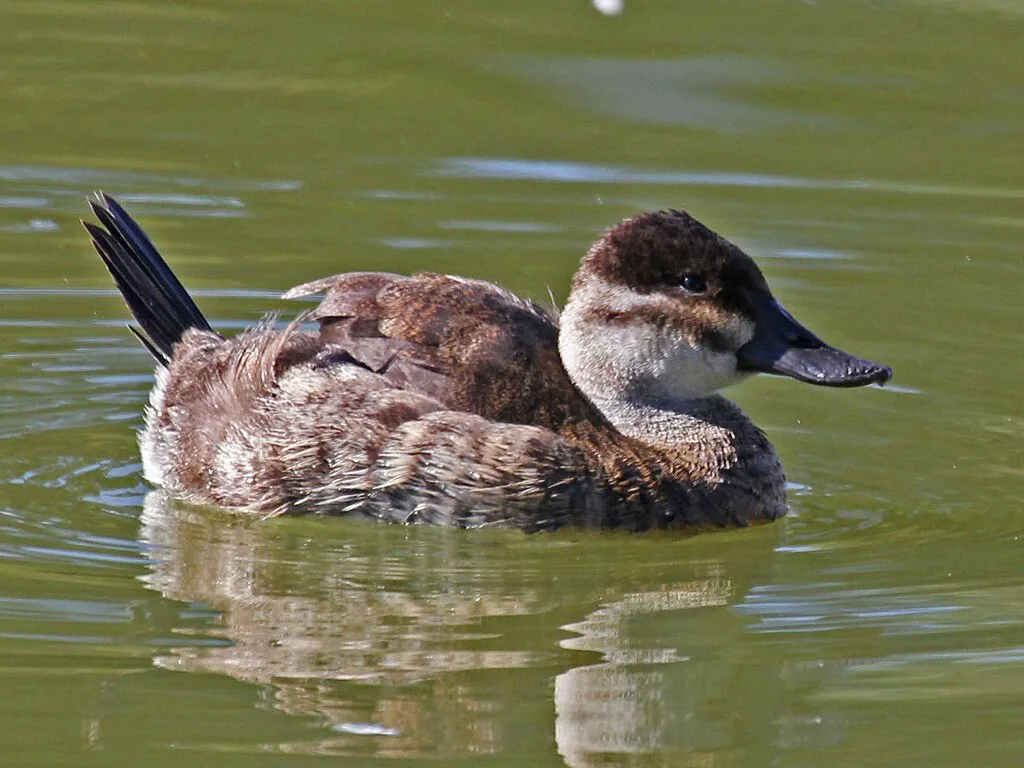
Appearance
The Ruddy Duck is a small, compact diving duck with a long, stiff tail that it often holds upright. Breeding males are unmistakable with a bright sky-blue bill, rich chestnut body, blackish crown, and white cheeks. Females and non-breeding males are duller brownish with a dark line across their pale cheeks, making them more cryptic.
Habitat and Range in Texas
Ruddy Ducks are common winter residents throughout Texas and breed in the Panhandle and western wetlands. You can spot them in:
- Freshwater ponds and lakes
- Marshes with dense aquatic vegetation
- Open reservoirs and coastal lagoons
They prefer shallow waters where they can easily dive for food.
Diet
Ruddy Ducks are diving feeders and forage underwater. Their diet includes:
- Aquatic insects and larvae
- Crustaceans
- Seeds of aquatic plants
- Small mollusks and zooplankton
They often feed at night or during twilight hours, using their broad bills to strain food from mud.
Behavior
These ducks are strong, agile divers but clumsy on land. They often sink low in the water when alarmed rather than fly away. Males perform elaborate courtship displays involving bubbling, tail shaking, and rapid bill-drumming on their chest.
Breeding (in Texas and beyond)
Ruddy Ducks build floating nests hidden in dense marsh vegetation. The female lays 5–10 eggs and raises the ducklings alone. Chicks are precocial, leaving the nest soon after hatching but staying near the female.
Fun Fact
Ruddy Duck eggs are unusually large relative to the hen’s body size—among the largest in proportion of any duck species!
15. Fulvous Whistling-Duck (Dendrocygna bicolor)
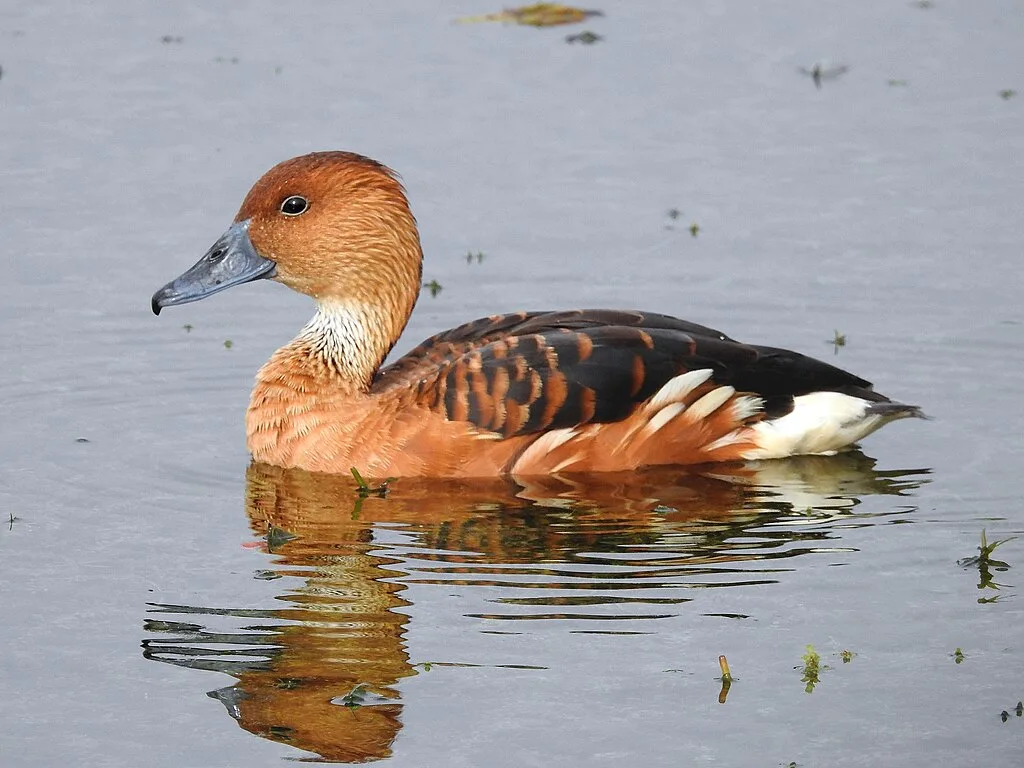
Appearance
The Fulvous Whistling-Duck is a striking, long-legged waterfowl with a tall neck and upright posture. Its plumage is mostly rich cinnamon or “fulvous” (tawny orange-brown), with a dark back and bold white stripe on each side. It has a bluish-gray bill and legs, and both sexes look alike.
Habitat and Range in Texas
This duck is a common summer breeder in southeastern Texas and along the Gulf Coast. You’ll find it in:
- Rice fields and flooded agricultural lands
- Freshwater marshes with dense vegetation
- Shallow ponds and reservoirs
They are most often seen in pairs or small groups rather than large flocks.
Diet
Fulvous Whistling-Ducks primarily feed at night, dabbling and tipping in shallow water. Their diet includes:
- Seeds of grasses, sedges, and aquatic plants
- Rice and other grains from farmlands
- Occasional aquatic invertebrates and insects
They forage both in water and in adjacent crop fields.
Behavior
These ducks are vocal and known for their loud, clear whistling calls, often heard in flight. They are strong fliers and form tight, synchronized groups. Fulvous Whistling-Ducks may roost in trees or elevated spots near water.
Breeding
In Texas, breeding occurs in late spring and summer. Nests are built on the ground among thick vegetation or on floating mats. The female lays 12–14 eggs, and both parents share incubation duties. Ducklings are active within hours of hatching.
Fun Fact
Unlike most ducks, Fulvous Whistling-Ducks have partially webbed feet and often perch in trees—more like geese than typical dabbling ducks!
16. Black-bellied Whistling-Duck (Dendrocygna autumnalis)
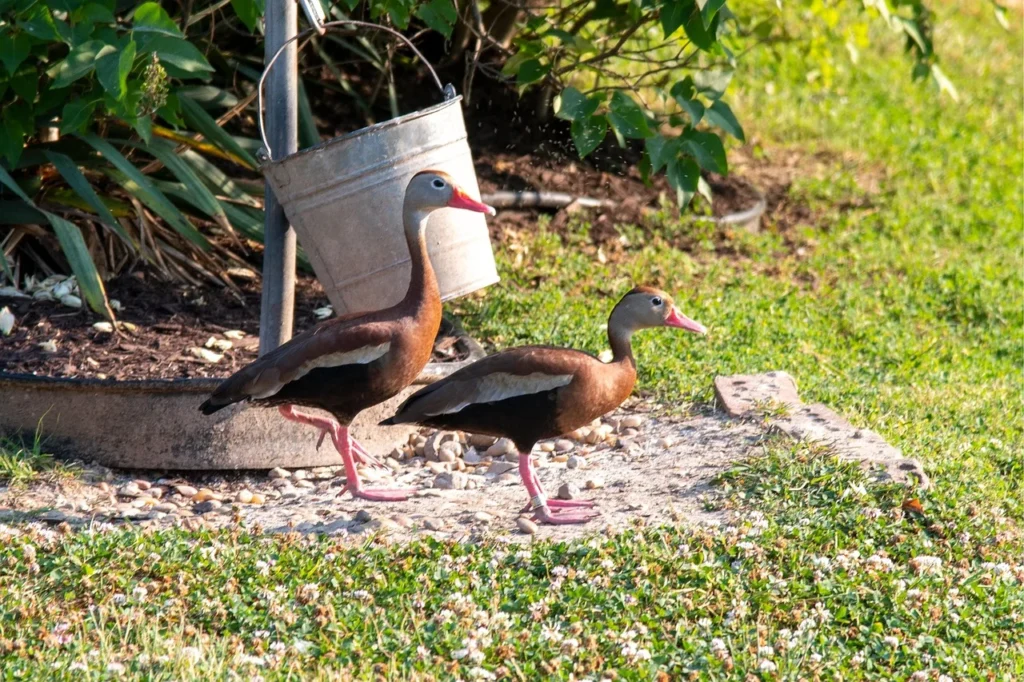
Appearance
This unique duck stands out with its long legs, upright stance, and vivid colors. Adults have a bright pink bill, a chestnut body, black belly, gray face, and white wing patches visible in flight. Both sexes look similar, and their goose-like shape often causes confusion.
Habitat and Range in Texas
Black-bellied Whistling-Ducks are common year-round residents in southern and eastern Texas. Look for them in:
- Freshwater ponds and reservoirs
- Agricultural fields, especially rice fields
- Wetlands and flooded pastures
- Urban parks and golf course ponds
They are adaptable and increasingly expanding northward in range.
Diet
These ducks are primarily herbivorous and forage by dabbling or grazing. Their diet includes:
- Grass seeds and aquatic vegetation
- Grains like rice, corn, and millet
- Occasional aquatic insects and snails
They often forage on land in the early morning and late evening.
Behavior
Highly social and vocal, Black-bellied Whistling-Ducks make high-pitched whistling calls. They are often seen perched on fence posts or tree limbs—unusual behavior for ducks. They form loose flocks and are comfortable around human activity.
Breeding
These cavity nesters often use tree holes or nest boxes near water. They breed from spring through summer, and both parents incubate 9–16 eggs. It’s common for multiple females to lay eggs in the same nest—sometimes over 40!
Fun Fact
Unlike most ducks, Black-bellied Whistling-Ducks don’t quack—they whistle! They also sometimes nest in owl boxes and can raise multiple broods each season.
17. Common Merganser (Mergus merganser)
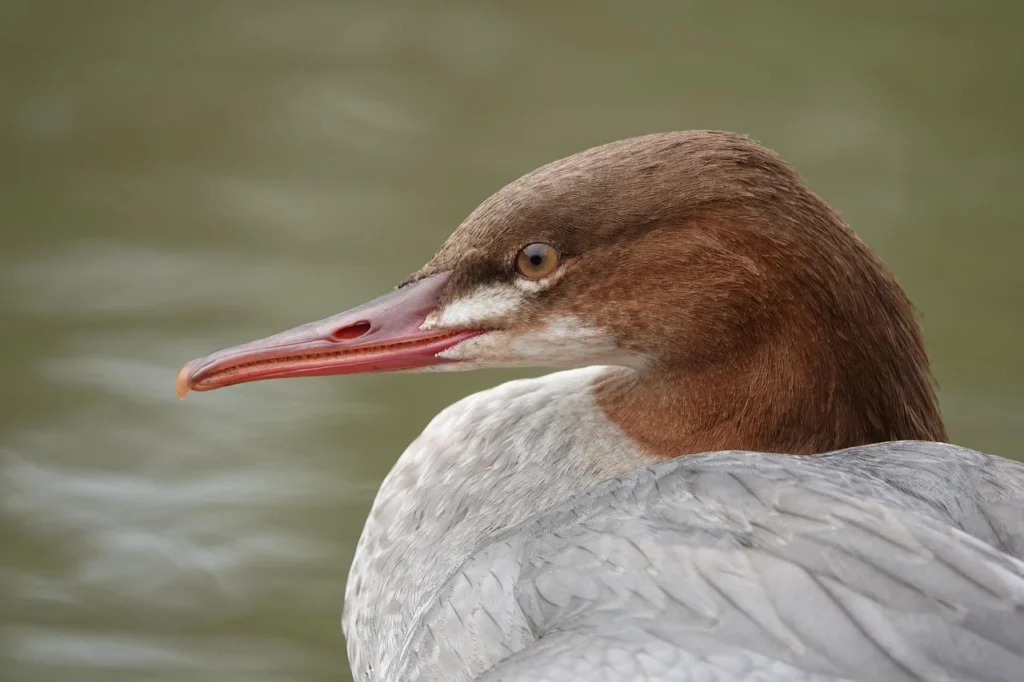
Appearance
The Common Merganser is a large, sleek duck with a long, slender red bill and a streamlined body. Males in breeding plumage have a dark green head, bright white body, and black back. Females and juveniles are gray-bodied with a rusty-brown head and a short crest at the back.
Habitat and Range in Texas
In Texas, Common Mergansers are rare but regular winter visitors, especially in the Panhandle and northern regions. You may spot them:
- On large, clear lakes and reservoirs
- Along slow-moving rivers
- In deep freshwater habitats with abundant fish
They prefer cold, clean waters and are less common in the southern half of the state.
Diet
Common Mergansers are diving ducks and expert fish hunters. Their serrated bills help grip slippery prey. Their diet includes:
- Small fish like minnows and perch
- Aquatic insects and crustaceans
- Occasionally amphibians and mollusks
They dive underwater and pursue fish with agile swimming.
Behavior
These ducks often form small flocks in winter. They are quiet and graceful, flying with rapid wingbeats. When alarmed, they flush quickly in a low flight over the water. Their dives are smooth and often deep in search of prey.
Breeding (Outside Texas)
They breed in forested areas near northern rivers and lakes. Nests are placed in tree cavities or nest boxes, often far from the water. Females lay 6–17 eggs and raise ducklings solo, leading them to water shortly after hatching.
Fun Fact
Common Mergansers can dive over 30 feet deep to catch fish and are among the few duck species that rely so heavily on live fish as their main food source.
18. Hooded Merganser (Lophodytes cucullatus)
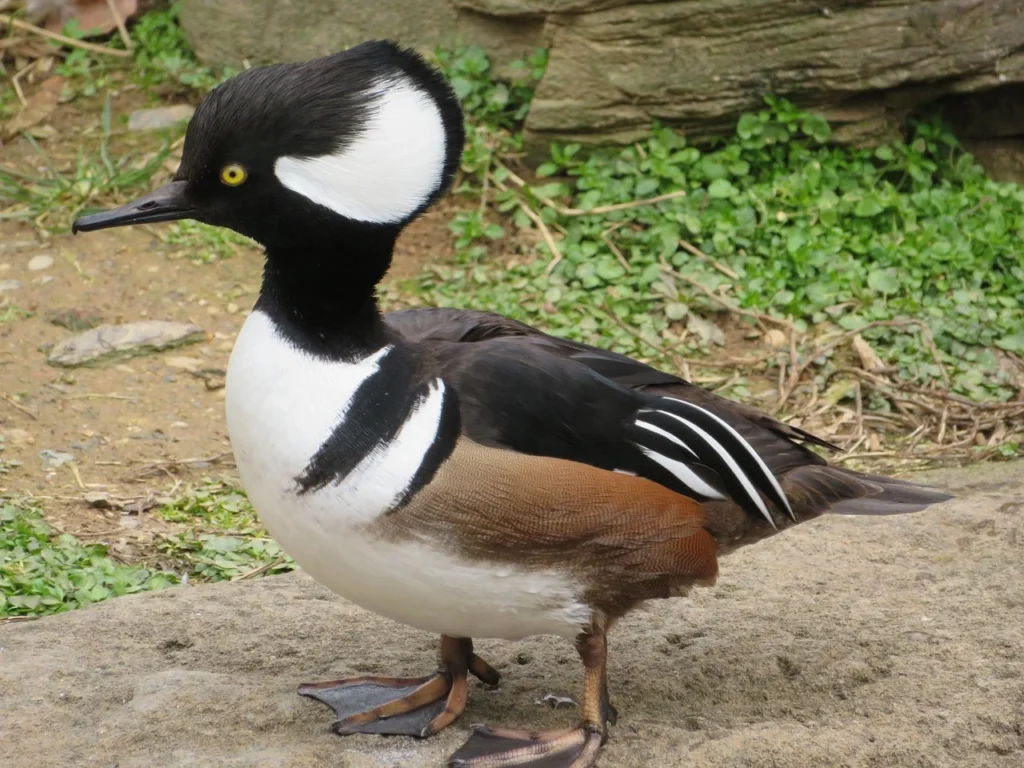
Appearance
The Hooded Merganser is a striking, small diving duck known for its large collapsible crest. Males have a bold black-and-white fan-shaped hood, yellow eyes, a dark back, and chestnut flanks. Females are brown overall with a cinnamon-toned crest and a more slender, dark bill.
Habitat and Range in Texas
In Texas, Hooded Mergansers are uncommon but regular winter visitors, especially from late fall through early spring. They are found in:
- Shallow wooded wetlands
- Cypress swamps and river sloughs
- Small lakes and ponds with overhanging trees
They prefer quiet, shaded water bodies with ample cover.
Diet
Hooded Mergansers are skilled visual hunters that dive to catch aquatic prey. Their diet includes:
- Small fish and crayfish
- Aquatic insects and larvae
- Frogs and other small amphibians
Their eyes adapt quickly to underwater vision, aiding their fishing accuracy.
Behavior
These ducks are fast and agile in water, diving frequently. They are typically solitary or seen in pairs and small groups. Males perform elaborate courtship displays by fanning their crests and shaking their heads.
Breeding (Outside Texas)
They nest in tree cavities near freshwater. Females lay 7–15 eggs in hollow trees or nest boxes. After hatching, ducklings leap from the cavity to the ground and follow the mother to water.
Fun Fact
The Hooded Merganser’s eyes adjust focus underwater like goggles, making it a superb aquatic predator despite its small size.
19. Red-breasted Merganser (Mergus serrator)
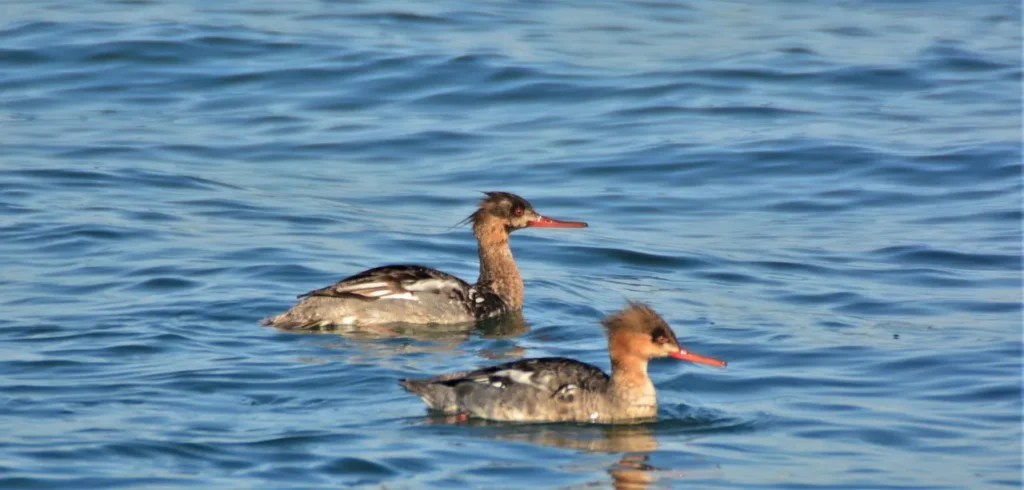
Appearance
The Red-breasted Merganser is a sleek diving duck with a spiky crest and long, narrow red bill. Males in breeding plumage feature a greenish-black head, rusty breast, white neck collar, and patterned flanks. Females and nonbreeding males are grayish with a brown head and ragged crest, giving them a scruffy appearance.
Habitat and Range in Texas
In Texas, Red-breasted Mergansers are mainly winter visitors and migrants, especially along the Gulf Coast. Look for them in:
- Coastal bays and estuaries
- Tidal lagoons and saltwater marshes
- Large inland lakes and reservoirs
They prefer open water and often form flocks during migration.
Diet
These mergansers are expert fish hunters and feed by diving and chasing prey underwater. Their diet includes:
- Small fish (main prey)
- Aquatic crustaceans
- Amphibians and aquatic insects
They use their serrated bills to grip slippery fish with ease.
Behavior
Red-breasted Mergansers are active swimmers and frequent divers. They are often seen in loose flocks and may feed cooperatively in groups. Their flight is fast and low over the water with rapid wingbeats.
Breeding (Outside Texas)
Breeding takes place in northern boreal forests and tundra near freshwater. Nests are shallow scrapes hidden in vegetation close to water. Females lay 6–12 eggs and raise the ducklings alone.
Fun Fact
Red-breasted Mergansers hold the world speed record for ducks—flapping at over 100 mph during level flight!
20. Common Goldeneye (Bucephala clangula)
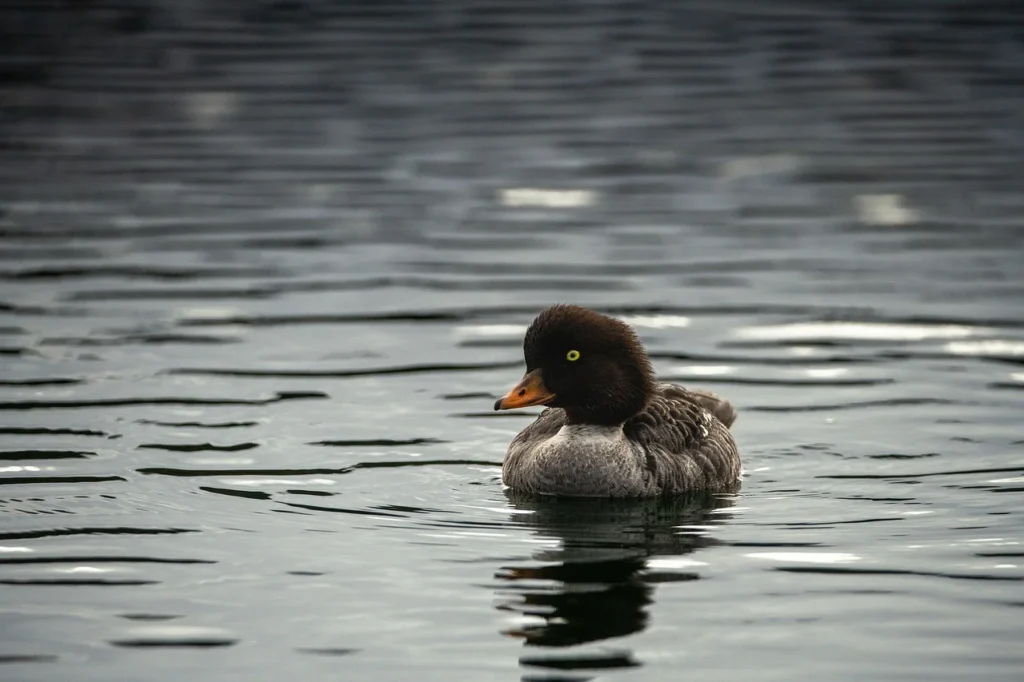
Appearance
The Common Goldeneye is a medium-sized diving duck with a striking appearance. Males are mostly black and white with a round white spot near the base of the bill and a glossy green-black head. Females have a chocolate-brown head, gray body, and yellow-tipped black bill. Both sexes have bright golden-yellow eyes that give the species its name.
Habitat and Range in Texas
Common Goldeneyes are uncommon but regular winter visitors in Texas. They’re mostly spotted in:
- Large reservoirs and lakes
- Slow-moving rivers
- Coastal bays and estuaries (occasionally)
They prefer clear, open water and tend to stay farther from shore than dabbling ducks.
Diet
These ducks are diving foragers, feeding underwater on a wide variety of prey. Their diet includes:
- Aquatic insects and larvae
- Crustaceans
- Mollusks and small fish
- Aquatic plants and seeds (occasionally)
They dive with agility and can stay submerged for extended periods.
Behavior
Goldeneyes are active and fast swimmers. They often forage alone or in small flocks. In flight, they produce a distinctive whistling sound with their wings, especially noticeable during takeoff.
Breeding (Outside Texas)
They nest in tree cavities in boreal forests across Canada and the northern U.S. Females may reuse the same nest annually, laying 6–12 eggs. Ducklings leap from the nest within a day of hatching and head straight for water.
Fun Fact
Despite being cavity nesters, Common Goldeneyes often lay their eggs in nests of other goldeneyes—a behavior called brood parasitism.
Duck-Like Species Found in Texas Wetlands
21. American Coot (Fulica americana)
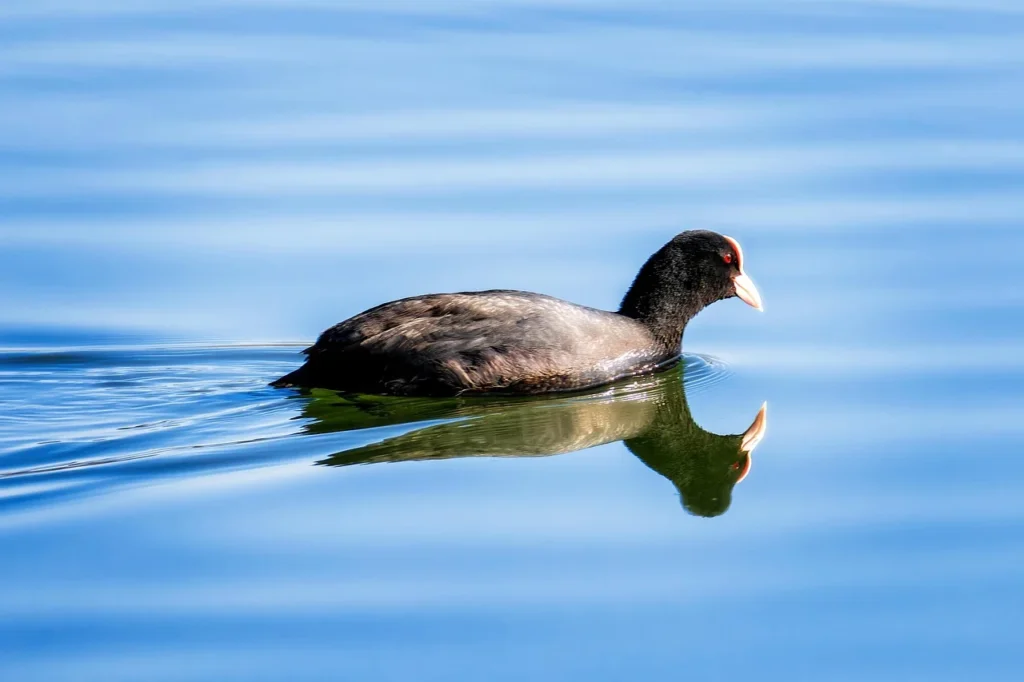
Appearance
Though often mistaken for a duck, the American Coot is not a true duck. It has:
- A slate-gray to black body
- A bright white, chicken-like bill
- A red eye and a small frontal shield above the beak
- Greenish-yellow legs with lobed toes instead of webbed feet
This distinct foot structure helps coots walk across muddy marshes and even on floating vegetation.
Habitat and Range in Texas
American Coots are year-round residents across Texas and can be found in:
- Ponds, lakes, marshes, and reservoirs
- Urban parks and golf course ponds
- Both freshwater and brackish environments
They are highly adaptable and often seen mingling with true duck species.
Diet
Coots are omnivores and flexible feeders. Their diet includes:
- Aquatic plants and algae
- Grasses and seeds
- Insects, crustaceans, and small fish
Unlike ducks, they frequently dive or dip their heads underwater while swimming to reach food.
Behavior
Coots are aggressive and territorial, often chasing off intruders with flapping and squawking displays. Despite their round, duck-like shape, their flight is labored and awkward—they often require a long running start across the water.
Their nasal “kuk-kuk” calls are common sounds in Texas wetlands
Nesting
Coots build floating nests anchored to vegetation. The female lays 8–12 eggs, and both parents share incubation and chick-rearing duties.
Fun Fact
Even though they look like ducks, American Coots are actually members of the rail family. Their fossil record in Texas goes back thousands of years, and they’re among the most commonly counted waterbirds during bird surveys.
22. Pied-billed Grebe (Podilymbus podiceps)
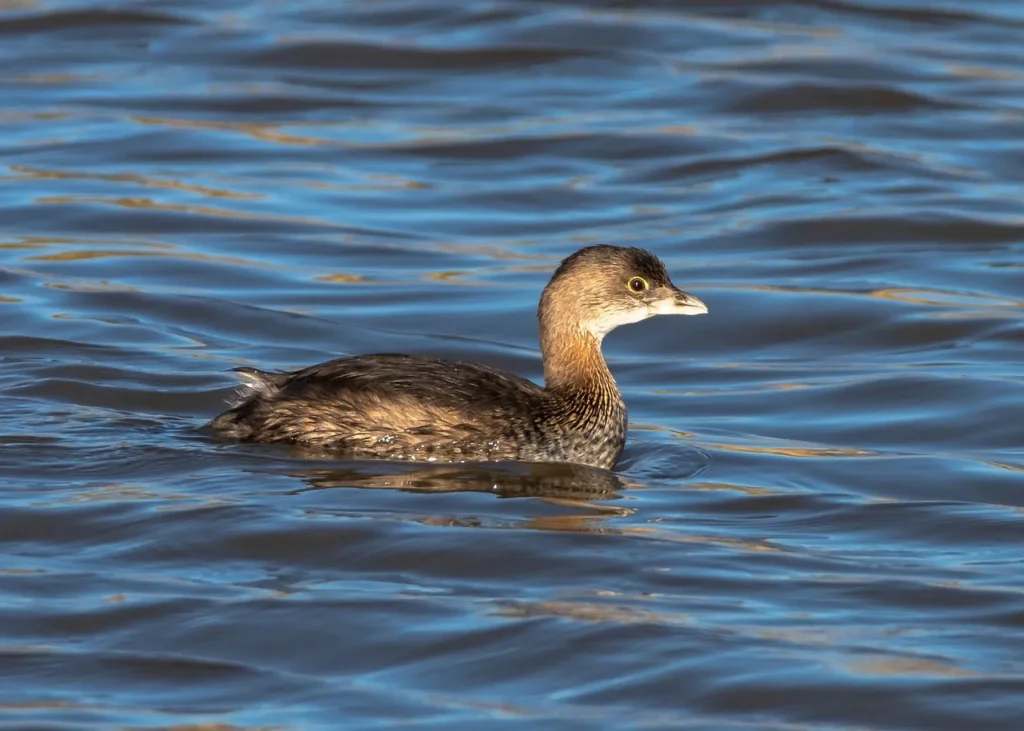
Appearance
At a glance, the Pied-billed Grebe may seem like a small brown duck, but it’s actually a member of the grebe family. It features:
- A compact, rounded body
- A stubby bill that’s pale with a dark vertical stripe (in breeding season)
- Brownish plumage with a slightly darker crown and back
- No tail — instead, its rear end looks fluffy or tapered in the water
Unlike ducks, grebes often swim very low in the water, with only their heads and upper backs visible.
Habitat and Range in Texas
Pied-billed Grebes are common year-round across much of Texas and are especially frequent in:
- Marshes
- Slow-moving rivers
- Ponds and lakes with dense shoreline vegetation
They prefer quiet, vegetated detlands, where they can dive and hide easily.
Diet
These birds are excellent divers that feed on:
- Small fish
- Aquatic insects and larvae
- Crustaceans
- Occasionally amphibians
They often swallow small prey underwater and even consume their own feathers to help digest bones and sharp items safely.
Behavior
Pied-billed Grebes are famously secretive and can sink like a submarine when threatened, vanishing almost instantly below the surface. They rarely fly unless migrating and are often seen alone or in pairs rather than flocks.
Their eerie, whooping call is often heard in spring and early summer.
Nesting
These grebes build floating nests anchored to reeds or cattails. Both male and female help incubate the eggs and care for the striped chicks, which often ride on the parents’ backs shortly after hatching.
Fun Fact
Despite their duck-like appearance, grebes are more closely related to flamingos than ducks. The Pied-billed Grebe is one of the most widespread grebes in North America — and a regular fixture in Texas wetlands.
23. Double-crested Cormorant (Nannopterum auritum)
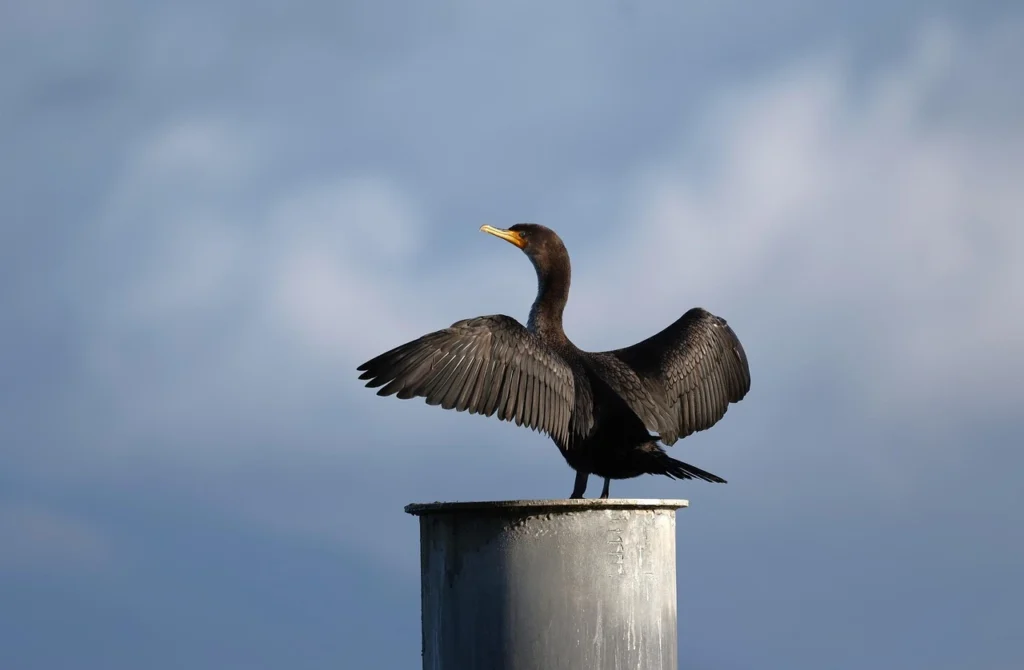
Appearance
The Double-crested Cormorant is a large, slender, dark waterbird with a long neck and hooked bill. Adults appear blackish overall, often with a slight green or bronze sheen. In breeding season, they develop two tufts of feathers—“double crests”—on either side of the head, though these can be hard to see.
Habitat and Range in Texas
Cormorants are common year-round residents throughout Texas, especially around large bodies of water. Typical habitats include:
- Freshwater lakes and reservoirs
- Coastal bays and estuaries
- Rivers and aquaculture ponds
- Docks, piers, and large snags for roosting
They’re frequently seen perched with wings outstretched to dry.
Diet
Double-crested Cormorants are voracious fish-eaters and expert divers. Their diet mainly includes:
- Small to medium-sized fish
- Crayfish and amphibians (occasionally)
- Aquatic insects and larvae
They pursue fish underwater using their strong legs and webbed feet.
Behavior
Unlike ducks, cormorants lack waterproofing oils, which is why they must dry their wings after diving. They swim low in the water with only their head and neck showing and often dive completely underwater for extended periods. Their flight is strong and direct, with neck outstretched and wings beating steadily.
Breeding
These birds nest in colonies, often on islands, cliffs, or tall trees. Nests are made of sticks and debris and reused yearly. Females lay 3–4 eggs, and both parents share incubation duties. Chicks are fed regurgitated fish until fledging.
Fun Fact
Because of their efficient fishing skills, cormorants are sometimes seen as a nuisance by fish farmers. Yet they play a vital role in aquatic ecosystems by controlling fish populations and cycling nutrients.
24. Common Gallinule (Gallinula galeata)
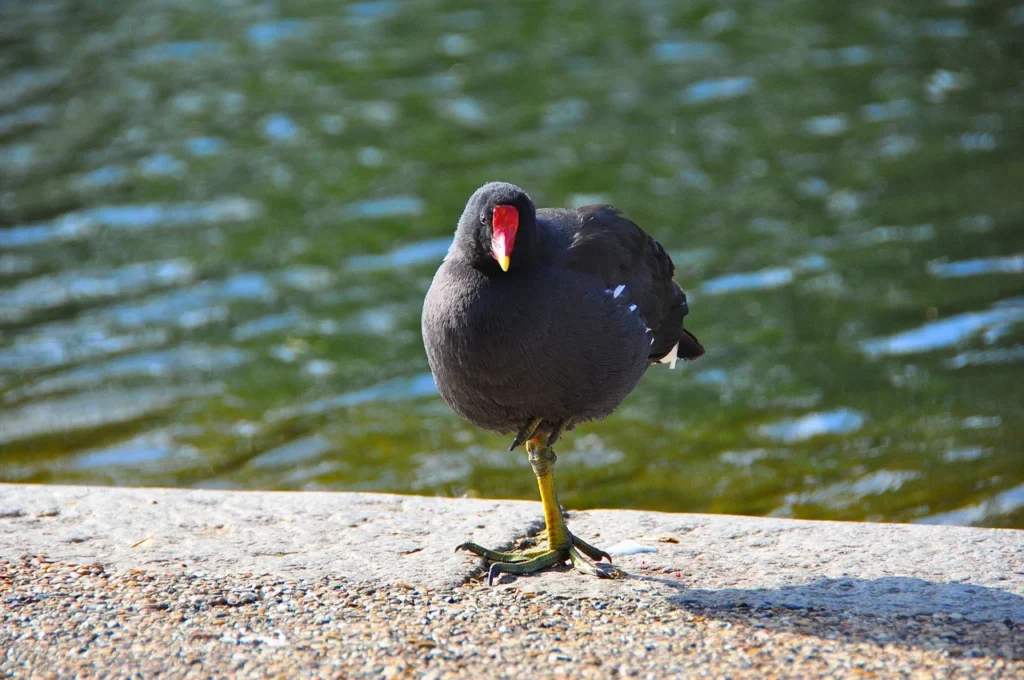
Appearance
The Common Gallinule, also known as the Common Moorhen, is a duck-like bird but can be easily distinguished by its bright red forehead shield and yellow-tipped red bill. Adults have a slate-black body, white flank stripes, and long greenish legs with unwebbed toes, ideal for walking on vegetation.
Habitat and Range in Texas
Common Gallinules are widespread year-round in Texas, especially in the warmer eastern and coastal regions. Preferred habitats include:
- Marshes and wetlands with dense emergent vegetation
- Edges of ponds, lakes, and bayous
- Rice paddies and flooded ditches
They prefer shallow waters with floating vegetation for foraging and nesting.
Diet
Gallinules are omnivores, feeding on both plant and animal matter. Their diet includes:
- Aquatic vegetation and seeds
- Insects and small snails
- Worms and crustaceans
- Algae and even frog eggs
They often pick food from the surface of the water or while wading.
Behavior
Though duck-like in shape, Gallinules swim with a jerky motion and often walk on floating plants. They are territorial during breeding season and may engage in fights. Known for their loud clucking calls, they often vocalize to maintain contact or defend their area.
Breeding
In Texas, breeding typically occurs in spring and summer. Nests are built in thick reeds or cattails, made from dead plant material. Females lay 5–10 eggs, and both parents help with incubation and chick-rearing. Chicks can swim almost immediately after hatching.
Fun Fact
Despite their aquatic lifestyle, Common Gallinules are strong runners and climbers. Their long toes help them navigate lily pads and reeds better than ducks can.
25. Neotropic Cormorant (Nannopterum brasilianum)
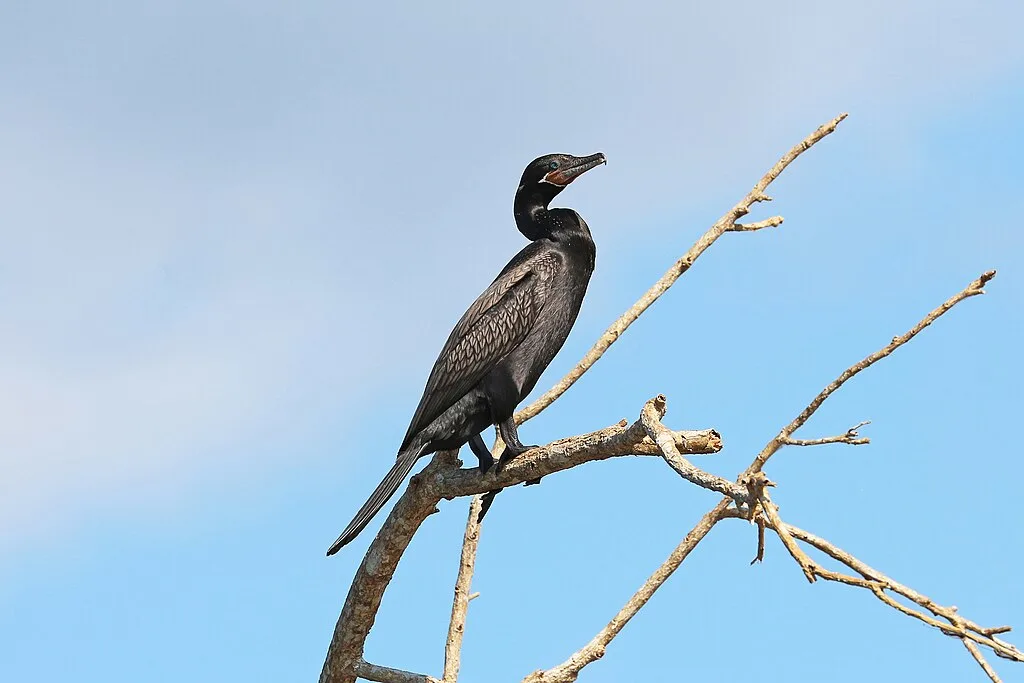
Appearance
The Neotropic Cormorant is a slender, dark waterbird with a long neck and thin, hooked bill. Adults are mostly black with a greenish sheen and have a faint white line on the face during breeding season. Their tail is relatively long, and they often perch with wings spread wide to dry after diving.
Habitat and Range in Texas
This cormorant species is widespread in Texas and can be found year-round in many regions. They are especially common in:
- Coastal bays and estuaries
- Inland lakes and reservoirs
- Marshes and slow-moving rivers
- Urban drainage canals and wetlands
They are highly adaptable and often seen perched on utility poles, snags, or docks near water.
Diet
Neotropic Cormorants are skilled underwater hunters. Their diet mainly consists of:
- Small fish (like sunfish, minnows, or shad)
- Crustaceans (especially crayfish)
- Amphibians and aquatic insects (occasionally)
They swallow prey headfirst and may be seen gulping it down at the water’s surface.
Behavior
These birds dive from the surface and pursue prey underwater using powerful kicks from their feet. After feeding, they often stand with wings outstretched to dry, as their feathers are not fully waterproof. Their call is a low, guttural grunt or croak, but they are mostly silent outside nesting areas.
Breeding
Neotropic Cormorants nest in colonies, often alongside herons and egrets. Nests are made of sticks and placed in trees, shrubs, or even on man-made structures near water. Pairs may raise 3–5 young per brood, and both parents help feed the chicks.
Fun Fact
Neotropic Cormorants are one of the only cormorant species that can frequently be seen flying low over highways and dry land—unusual behavior for a waterbird!
Where to Spot Ducks in Texas
With its vast wetlands, reservoirs, and coastal zones, Texas is a duck-watching paradise year-round. Whether you’re in the Panhandle or the Gulf Coast, these are some of the best locations to find both migratory and resident ducks:
1. Aransas National Wildlife Refuge (Gulf Coast)
- Best for: Wintering waterfowl, including Northern Pintail, Gadwall, Redheads, and American Wigeons.
- Habitat: Salt marshes, brackish flats, and tidal estuaries.
- Bonus: Also home to the endangered Whooping Crane.
2. Anahuac National Wildlife Refuge (Southeast Texas)
- Best for: Dabbling ducks, such as Blue-winged Teal and Mottled Ducks.
- Features: Coastal prairie and marshes that attract thousands of ducks each migration season.
3. Caddo Lake State Park (East Texas)
- Best for: Wood Ducks, Hooded Mergansers, and secretive Pied-billed Grebes.
- Habitat: Cypress swamps and bayous make for magical birding.
4. Muleshoe National Wildlife Refuge (Texas Panhandle)
- Best for: Diving ducks, including Ruddy Ducks and Ring-necked Ducks.
- Note: Seasonal playa lakes draw massive waterfowl numbers during migration.
5. Lake Texoma and Lake Buchanan (North & Central Texas)
- Best for: Canvasbacks, Common Mergansers, and large rafts of mixed duck species.
- Features: Open water with plenty of aquatic vegetation and protected coves.
6. Urban Water Bodies (Statewide)
- Cities like Houston, Dallas, Austin, and San Antonio have:
- Park ponds
- Golf course lakes
- Urban wetlands
- Expect: Mallards, American Coots, and Blue-winged Teals year-round.
FAQ
What is the most common duck in Texas?
The Mallard (Anas platyrhynchos) is one of the most common ducks found throughout Texas. It thrives in both urban and wild wetlands, including ponds, lakes, and marshes. Mallards are easily identified by the male’s glossy green head and the female’s mottled brown plumage. Their adaptability and abundance make them a familiar sight for birdwatchers across the state.
Are there any rare or unusual ducks in Texas?
Yes, Texas occasionally hosts rare duck species such as the Harlequin Duck and the Long-tailed Duck, particularly along the Gulf Coast during migration. These species are not commonly found in the region and are considered exciting sightings for experienced birders. Their appearances are usually seasonal and may vary year to year depending on weather and migration patterns.
Where is the best place to see ducks in Texas?
Some of the best places to see ducks in Texas include Aransas National Wildlife Refuge, Caddo Lake, Anahuac National Wildlife Refuge, and the Texas Coast during winter. Inland lakes like Lake Somerville and Lake Tawakoni are also excellent spots for viewing both migratory and resident ducks.
When is duck migration season in Texas?
Duck migration in Texas typically peaks from October through February. This is when migratory waterfowl travel south along the Central Flyway. Early migrants like Blue-winged Teal arrive in September, while others, such as Northern Pintails and Green-winged Teals, stay through the winter months.
What duck species can be hunted in Texas?
Texas allows regulated duck hunting for several species, including Mallards, Gadwalls, Northern Pintails, Teal, Wigeons, and Shovelers. Hunting seasons and bag limits are set annually by the Texas Parks and Wildlife Department. Always check the latest regulations before heading out.
Conclusion
From the vibrant Green-winged Teal to the majestic Wood Duck and the exotic Muscovy, Texas is a true haven for duck lovers. With over 30 true duck species and several fascinating duck-like birds roaming the state’s lakes, marshes, and coastal wetlands, there’s always something new to discover. Whether you’re birdwatching with binoculars or exploring with a field guide in hand, the Lone Star State offers endless opportunities to experience the beauty and diversity of waterfowl.
Grab your gear, head to your nearest wetland, and keep your eyes open—there’s a good chance your next favorite duck is waiting just beyond the reeds.

Welcome to World Birds Life, where the wonder of birds takes center stage. My name is Lexi, and I’m passionate about helping you discover the beauty and joy that birds bring into our lives.

